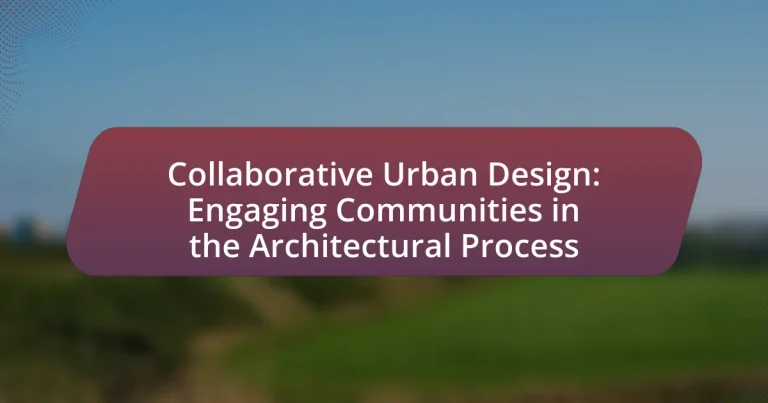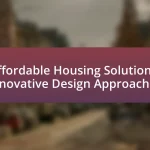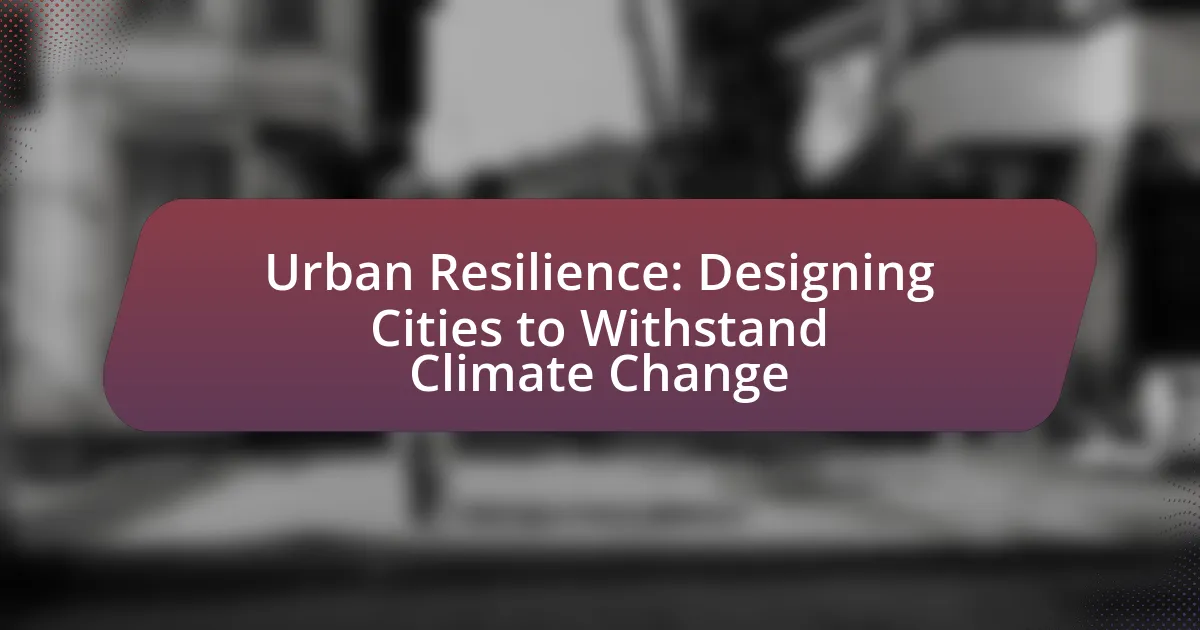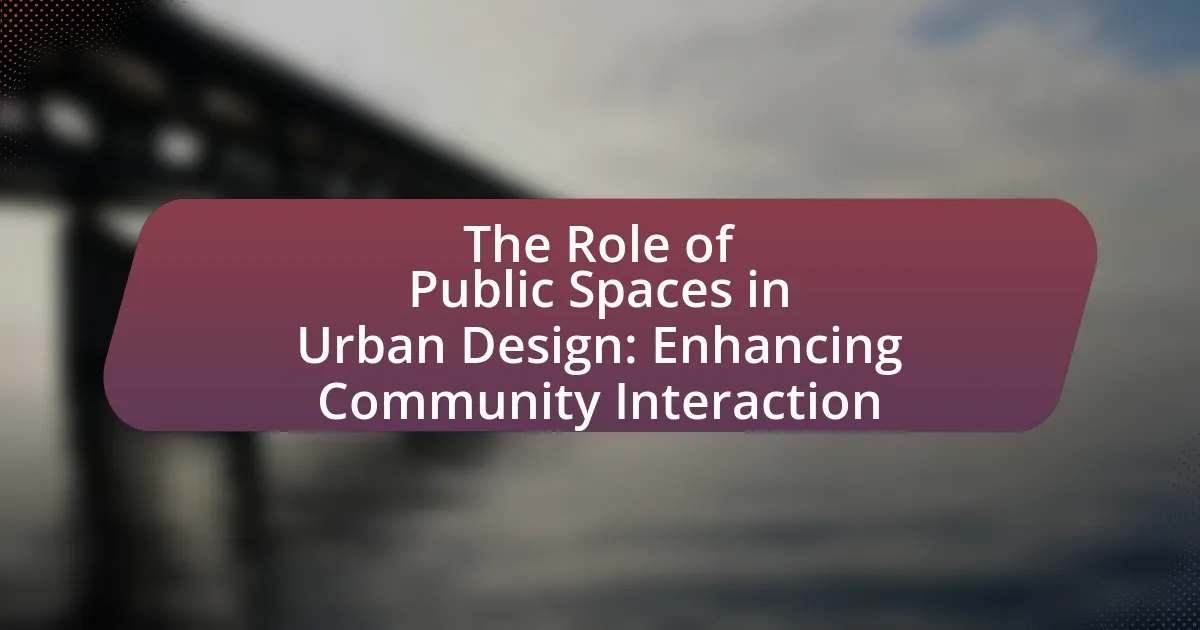Collaborative Urban Design is a process that involves various stakeholders, including community members, architects, urban planners, and local governments, working together to shape urban environments. This approach emphasizes community engagement, inclusivity, sustainability, and adaptability, leading to designs that reflect the needs and desires of residents. The article explores how community involvement enhances urban design outcomes, the methods used in participatory design workshops, the role of technology in facilitating engagement, and the long-term benefits of collaborative practices. It also addresses the challenges faced by traditional urban design and highlights best practices for ensuring diverse community representation in the design process.

What is Collaborative Urban Design?
Collaborative Urban Design is a process that involves multiple stakeholders, including community members, architects, urban planners, and local governments, working together to shape the physical environment of urban spaces. This approach emphasizes the importance of community engagement and input in the design process, ensuring that the needs and desires of residents are considered in the development of public spaces, infrastructure, and housing. Research indicates that projects utilizing collaborative urban design often result in more sustainable and socially inclusive outcomes, as they reflect the diverse perspectives and requirements of the community.
How does Collaborative Urban Design engage communities?
Collaborative Urban Design engages communities by actively involving them in the planning and decision-making processes of urban development. This approach fosters a sense of ownership and empowerment among community members, as they contribute their insights, needs, and preferences, which are essential for creating spaces that reflect their values and aspirations. Research indicates that projects utilizing collaborative design methods often result in higher satisfaction rates and better alignment with community needs, as evidenced by case studies such as the participatory design initiatives in cities like Copenhagen and Melbourne, where community feedback directly influenced urban policies and designs.
What are the key principles of Collaborative Urban Design?
The key principles of Collaborative Urban Design include community engagement, inclusivity, sustainability, and adaptability. Community engagement ensures that local voices are heard and incorporated into the design process, fostering a sense of ownership among residents. Inclusivity promotes the participation of diverse groups, ensuring that the needs of all community members are considered. Sustainability focuses on creating environmentally responsible designs that enhance the urban ecosystem, while adaptability allows designs to evolve based on changing community needs and contexts. These principles are supported by case studies demonstrating successful urban projects that prioritize community involvement and sustainable practices, such as the participatory design processes seen in cities like Copenhagen and Melbourne.
How does community involvement shape urban design outcomes?
Community involvement significantly shapes urban design outcomes by ensuring that the needs and preferences of residents are integrated into the planning process. When communities actively participate, they provide valuable insights that lead to designs that reflect local culture, enhance usability, and promote social cohesion. Research indicates that projects with strong community engagement, such as the “Community Design Collaborative” in Philadelphia, result in higher satisfaction rates and better long-term sustainability. This involvement not only fosters a sense of ownership among residents but also leads to more effective and contextually relevant urban spaces.
Why is Collaborative Urban Design important in modern architecture?
Collaborative Urban Design is important in modern architecture because it fosters community engagement and ensures that the built environment reflects the needs and desires of its users. This approach enhances the relevance and sustainability of architectural projects by incorporating diverse perspectives, which leads to more innovative and effective design solutions. Research indicates that projects involving community participation often result in higher satisfaction rates and increased social cohesion, as seen in studies conducted by the American Planning Association, which highlight the positive impacts of community involvement on urban development outcomes.
What challenges does traditional urban design face?
Traditional urban design faces challenges such as a lack of community engagement, insufficient adaptability to changing needs, and environmental sustainability issues. The traditional approach often prioritizes top-down planning, which can alienate local residents and overlook their needs, leading to designs that do not reflect the community’s identity or requirements. Additionally, urban environments are dynamic, and traditional designs may not effectively accommodate evolving demographics or technological advancements. Furthermore, the increasing emphasis on sustainability highlights the inadequacies of conventional methods in addressing climate change and resource management, necessitating a shift towards more innovative and inclusive practices.
How does Collaborative Urban Design address these challenges?
Collaborative Urban Design addresses challenges by fostering inclusive participation among stakeholders, ensuring that diverse community voices shape urban spaces. This approach mitigates conflicts and enhances project relevance by integrating local knowledge and preferences into the design process. Evidence shows that projects involving community engagement, such as the participatory design initiatives in cities like Barcelona, lead to higher satisfaction rates and better alignment with residents’ needs, ultimately resulting in more sustainable and functional urban environments.

What methods are used in Collaborative Urban Design?
Collaborative Urban Design employs methods such as participatory design workshops, stakeholder engagement sessions, and design charrettes. Participatory design workshops involve community members in the design process, allowing them to express their needs and preferences, which enhances the relevance of the design outcomes. Stakeholder engagement sessions facilitate dialogue between various interest groups, ensuring that diverse perspectives are considered, which is crucial for achieving consensus. Design charrettes are intensive, collaborative sessions where designers and community members work together to generate ideas and solutions, often resulting in innovative urban design proposals. These methods are validated by case studies demonstrating improved community satisfaction and project success rates when stakeholders are actively involved in the design process.
How do participatory design workshops function?
Participatory design workshops function by actively involving stakeholders, including community members, in the design process to ensure that their needs and preferences are integrated into the final outcomes. These workshops typically employ various interactive methods such as brainstorming sessions, sketching, and prototyping, allowing participants to express their ideas and feedback in a collaborative environment. Research indicates that this approach enhances user satisfaction and leads to more relevant design solutions, as evidenced by studies showing that projects incorporating community input often result in higher levels of acceptance and usability.
What tools are utilized in participatory design workshops?
Participatory design workshops utilize tools such as sketching materials, digital modeling software, physical prototypes, and interactive mapping tools. These tools facilitate collaboration among participants, allowing them to express ideas visually and spatially. For instance, sketching materials enable quick visualization of concepts, while digital modeling software like SketchUp or AutoCAD allows for detailed design exploration. Physical prototypes help participants engage with tangible representations of their ideas, and interactive mapping tools, such as GIS software, assist in analyzing spatial relationships and community needs. The effectiveness of these tools is supported by their ability to enhance communication and foster creativity among diverse stakeholders in the design process.
How do these workshops facilitate community input?
Workshops facilitate community input by providing structured environments where residents can express their ideas and concerns regarding urban design. These sessions encourage active participation through interactive activities, such as brainstorming and feedback exercises, which allow community members to voice their perspectives directly to planners and architects. Research indicates that such engagement leads to more relevant and accepted design outcomes, as evidenced by case studies where community-driven projects resulted in higher satisfaction rates among residents.
What role does technology play in Collaborative Urban Design?
Technology plays a crucial role in Collaborative Urban Design by facilitating communication, data analysis, and participatory engagement among stakeholders. It enables real-time collaboration through digital platforms, allowing architects, urban planners, and community members to share ideas and feedback efficiently. For instance, Geographic Information Systems (GIS) provide spatial data that helps visualize urban environments, while Building Information Modeling (BIM) enhances project coordination and reduces errors. Additionally, tools like virtual reality (VR) and augmented reality (AR) allow stakeholders to experience designs interactively, fostering a deeper understanding of proposed changes. These technological advancements not only streamline the design process but also empower communities to actively participate in shaping their environments, leading to more inclusive and sustainable urban solutions.
How can digital platforms enhance community engagement?
Digital platforms enhance community engagement by providing accessible channels for communication and collaboration among community members. These platforms facilitate real-time feedback, allowing residents to share their ideas and concerns regarding urban design projects. For instance, studies show that using platforms like social media and dedicated community apps can increase participation rates in local planning initiatives by up to 40%. Additionally, digital tools such as virtual town halls and interactive mapping software enable residents to visualize proposed changes and contribute to the design process, fostering a sense of ownership and investment in their community.
What are the benefits of using virtual reality in urban design?
The benefits of using virtual reality in urban design include enhanced visualization, improved stakeholder engagement, and effective design iteration. Enhanced visualization allows designers and stakeholders to experience a realistic representation of urban spaces before construction, facilitating better understanding and communication of design concepts. Improved stakeholder engagement occurs as community members can immerse themselves in virtual environments, providing valuable feedback and fostering a sense of ownership in the design process. Effective design iteration is achieved through the ability to quickly modify and visualize changes in real-time, leading to more informed decision-making and ultimately better urban outcomes. These benefits are supported by studies showing that virtual reality can increase participant satisfaction and collaboration in urban planning projects.

What are the outcomes of Collaborative Urban Design?
The outcomes of Collaborative Urban Design include enhanced community engagement, improved design quality, and increased social equity. Enhanced community engagement occurs as stakeholders actively participate in the design process, leading to solutions that reflect the needs and desires of the community. Improved design quality results from diverse perspectives being integrated, which fosters innovation and creativity in urban spaces. Increased social equity is achieved by ensuring that marginalized voices are included, promoting inclusivity and addressing disparities in urban development. These outcomes are supported by case studies demonstrating that projects involving community collaboration often yield higher satisfaction rates and better long-term sustainability.
How does Collaborative Urban Design impact community satisfaction?
Collaborative Urban Design significantly enhances community satisfaction by actively involving residents in the planning and decision-making processes. This engagement fosters a sense of ownership and belonging among community members, leading to increased satisfaction with public spaces and amenities. Research indicates that projects incorporating community input often result in designs that better reflect the needs and desires of the population, ultimately improving the quality of life. For instance, a study published in the Journal of Urban Design found that neighborhoods with participatory design processes reported higher levels of satisfaction and social cohesion compared to those without such involvement.
What metrics are used to measure community satisfaction?
Community satisfaction is measured using metrics such as surveys, focus groups, and community engagement indices. Surveys often include questions about residents’ perceptions of safety, accessibility, and amenities, providing quantitative data on satisfaction levels. Focus groups allow for qualitative insights into community needs and preferences, while community engagement indices assess participation in local decision-making processes. These metrics are validated by studies showing that higher engagement correlates with increased satisfaction, as evidenced by research from the Urban Institute, which highlights the importance of community involvement in urban planning for enhancing overall satisfaction.
How do successful projects reflect community needs?
Successful projects reflect community needs by actively involving community members in the planning and design process, ensuring that their voices and preferences shape the outcomes. For instance, projects that incorporate feedback through surveys, workshops, or public meetings are more likely to address specific local issues, such as accessibility, safety, and cultural relevance. Research by the American Planning Association indicates that community engagement leads to higher satisfaction rates and better project outcomes, as seen in initiatives like the participatory budgeting process in various cities, which directly allocates funds based on community priorities.
What are the long-term benefits of Collaborative Urban Design?
Collaborative Urban Design leads to sustainable communities, improved social cohesion, and enhanced public spaces. By involving diverse stakeholders in the design process, it ensures that urban environments meet the needs of all residents, fostering a sense of ownership and belonging. Research indicates that cities employing collaborative design practices experience increased civic engagement and reduced conflict over land use, as seen in the case of the participatory planning initiatives in Portland, Oregon, which resulted in higher satisfaction rates among residents. Furthermore, studies show that well-designed public spaces contribute to economic growth, with a report from the Project for Public Spaces highlighting that vibrant public areas can increase local business revenues by up to 30%.
How does it contribute to sustainable urban development?
Collaborative urban design contributes to sustainable urban development by fostering community engagement in the architectural process, which leads to more inclusive and context-sensitive solutions. This approach ensures that the needs and preferences of local residents are prioritized, resulting in urban spaces that enhance social cohesion and environmental sustainability. Research indicates that projects involving community participation often achieve higher satisfaction rates and better long-term outcomes, as seen in the case of the participatory design initiatives in cities like Copenhagen, where public input has led to the creation of green spaces and improved public transport systems.
What are the economic benefits for communities involved?
Collaborative urban design provides significant economic benefits for involved communities, including increased property values, enhanced local business opportunities, and improved public infrastructure. Studies indicate that neighborhoods engaged in collaborative design processes often experience a rise in property values by 10-20%, as community members invest in their surroundings and attract new residents. Additionally, local businesses benefit from increased foot traffic and customer engagement, leading to higher sales and job creation. Improved public infrastructure, such as parks and transportation, further stimulates economic growth by making areas more attractive for investment and tourism.
What best practices should be followed in Collaborative Urban Design?
Best practices in Collaborative Urban Design include engaging stakeholders early in the design process, fostering open communication, and utilizing participatory design techniques. Engaging stakeholders from the outset ensures that diverse perspectives are considered, which enhances the relevance and acceptance of the design. Open communication facilitates transparency and trust among participants, leading to more effective collaboration. Participatory design techniques, such as workshops and charrettes, allow community members to actively contribute their ideas and feedback, resulting in designs that better reflect the needs and desires of the community. These practices are supported by case studies demonstrating improved project outcomes and community satisfaction when stakeholders are involved throughout the design process.
How can designers effectively facilitate community dialogue?
Designers can effectively facilitate community dialogue by employing inclusive design practices that actively engage diverse community members in the decision-making process. This approach ensures that all voices are heard and valued, fostering a sense of ownership and collaboration among participants. For instance, utilizing methods such as workshops, surveys, and public forums allows designers to gather input and feedback directly from the community, which can lead to more relevant and accepted design outcomes. Research by the American Planning Association indicates that community engagement in urban design leads to projects that better reflect the needs and desires of residents, ultimately enhancing community satisfaction and cohesion.
What strategies ensure diverse community representation?
Strategies that ensure diverse community representation include inclusive stakeholder engagement, equitable access to decision-making processes, and the use of participatory design methods. Inclusive stakeholder engagement involves actively reaching out to underrepresented groups to gather their input and perspectives, ensuring that all voices are heard. Equitable access to decision-making processes guarantees that marginalized communities have the opportunity to influence outcomes, which can be facilitated through community advisory boards or public forums. Participatory design methods, such as workshops and charrettes, allow community members to collaborate directly with designers and planners, fostering a sense of ownership and ensuring that the final designs reflect the diverse needs and values of the community. These strategies are supported by research indicating that diverse representation leads to more innovative and effective urban solutions, as highlighted in studies by the American Planning Association, which emphasize the importance of community involvement in urban planning.





